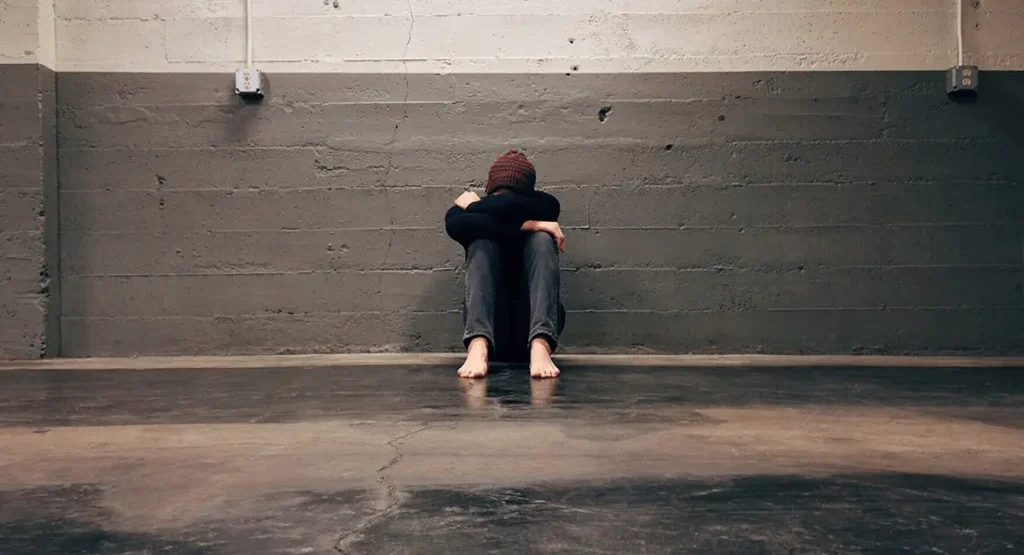
Anxiety affects approximately 301 million people worldwide, making it the most common mental health condition globally according to the World Health Organization. Yet many people struggle to recognize when their daily worries have crossed the line into something more serious.
Understanding anxiety signs and symptoms isn’t just about getting a diagnosis. It’s about reclaiming your life from the invisible chains that keep you from living fully. Whether you’re experiencing your first panic attack or you’ve been battling anxious thoughts for years, recognizing these patterns is the first step toward feeling better.
In this guide, you’ll discover how to identify the physical, emotional, and behavioral signs of anxiety, learn about different anxiety disorders, and find proven strategies that actually work when anxiety tries to take control.
Related: The Ultimate Mental Health Guide: Managing Stress, Anxiety, and Building Emotional Resilience
Why Does Your Heart Race When Nothing Scary Is Happening?
Your body doesn’t lie. When anxiety strikes, it often shows up physically first, sometimes before you even realize you’re worried about something. These physical symptoms of anxiety can be confusing and frightening, especially when they happen without an obvious trigger.
The mystery of sudden rapid heartbeat and palpitations is one of the most common anxiety symptoms. Your heart might pound so hard you can hear it in your ears, or it might skip beats in a way that makes you wonder if something is seriously wrong. This happens because anxiety triggers your body’s fight-or-flight response, flooding your system with stress hormones like adrenaline.
When your body feels like it’s running a marathon while sitting still, you’re experiencing the hyperarousal that comes with anxiety disorders. Your breathing becomes shallow and rapid, sometimes leading to hyperventilation. You might feel like you can’t catch your breath or like there’s not enough air in the room, even when you’re in a perfectly ventilated space.
Sweating, trembling, and shaking without obvious cause are telltale signs your nervous system is in overdrive. You might notice your hands shake when you try to sign a document, or you might break out in a cold sweat during a normal conversation. These symptoms occur because anxiety activates your sympathetic nervous system, preparing your body to respond to perceived danger.
The invisible weight of muscle tension and unexplained headaches affects nearly everyone with anxiety. Your shoulders might feel like they’re carrying bricks, your jaw might be constantly clenched, or you might wake up with headaches that seem to come from nowhere. Chronic muscle tension is your body’s way of staying ready for action, but it becomes exhausting over time.
Why your stomach churns during normal conversations relates to the gut-brain connection. Anxiety can cause nausea, butterflies, stomach cramps, or even digestive issues like diarrhea or constipation. The American Psychological Association notes that gastrointestinal symptoms are among the most common physical manifestations of anxiety disorders.
The exhaustion paradox of feeling tired but unable to rest creates a vicious cycle. Anxiety burns through your energy reserves, leaving you feeling drained, yet your mind won’t quiet down enough to let you truly rest. You might feel tired all day but find yourself wide awake at bedtime, mind racing with worries.
When the room starts spinning and you haven’t moved, you’re experiencing anxiety-related dizziness or lightheadedness. This happens because anxiety can affect your inner ear balance or cause changes in your breathing patterns that reduce oxygen to your brain.
Also read: The Ultimate Mental Health Guide: Managing Stress, Anxiety, and Building Emotional Resilience
Is Your Mind Playing Tricks on You or Is This Really Anxiety?
The mental and emotional symptoms of anxiety can be even more distressing than physical ones because they make you question your own thoughts and reality. Understanding these patterns helps you recognize when anxiety is driving your thoughts rather than genuine concerns.
The “what if” spiral that never seems to end is perhaps the most recognizable sign of anxiety. Your mind jumps from one worry to the next, creating elaborate disaster scenarios. “What if I’m late for the meeting? What if my boss thinks I’m unreliable? What if I lose my job? What if I can’t pay rent?” Each thought builds on the last, creating a mountain of worry from a molehill of reality.
Why small problems feel like life-or-death situations happens because anxiety hijacks your threat detection system. A delayed text message becomes evidence that someone is angry with you. A minor mistake at work feels like career suicide. This catastrophic thinking is a hallmark of anxiety disorders, where your brain treats everyday stressors as genuine emergencies.
When your brain won’t stop chattering at 3 AM, you’re experiencing racing thoughts, another common anxiety symptom. Your mind might jump rapidly between different topics, replay conversations from earlier, or get stuck in loops of repetitive thinking. Sleep becomes impossible when your brain refuses to shift into rest mode.
The feeling of drowning in your own thoughts describes the overwhelming nature of anxiety. You might feel like you can’t think clearly, make decisions, or focus on tasks that used to be simple. This cognitive fog happens because anxiety consumes so much mental energy that there’s little left for normal thinking processes.
Why everything feels like too much, too fast, too overwhelming is your emotional regulation system struggling to cope. Normal daily tasks feel insurmountable. Simple decisions like what to eat for lunch become major productions. This emotional overwhelm often leads to irritability, mood swings, or feeling like you’re constantly on edge.
The crystal ball syndrome of always predicting disaster involves anticipatory anxiety, where you experience intense worry about future events that may never happen. You might avoid making plans because you’re already anxious about everything that could go wrong, or you might spend hours preparing for scenarios that exist only in your imagination.
When avoiding becomes easier than facing situations, you’ve crossed into anxiety-driven avoidance. You might skip social events, avoid certain places, or procrastinate on important tasks because the thought of doing them triggers too much anxiety. While avoidance provides temporary relief, it typically makes anxiety stronger over time.
Are You Becoming a Stranger to Yourself?
Behavioral changes are often the most noticeable signs of anxiety to friends and family, even when you don’t realize how much your actions have shifted. These changes represent your attempts to cope with internal anxiety, but they can end up making life smaller and more restricted.
Why you suddenly don’t want to see friends anymore often starts gradually. Social anxiety might make gatherings feel exhausting rather than enjoyable. You might worry about being judged, saying something embarrassing, or having an anxiety attack in public. What once felt natural now requires enormous mental energy, so you begin declining invitations or making excuses to avoid social situations.
The art of putting everything off until “tomorrow” becomes a survival strategy when anxiety makes tasks feel overwhelming. Procrastination provides temporary relief from anxiety-provoking activities, but it creates a cycle where the delayed task becomes even more anxiety-inducing over time. Important emails go unanswered, bills pile up, and deadlines loom larger.
When food becomes your enemy or your only comfort reflects how anxiety disrupts normal eating patterns. Some people lose their appetite entirely, feeling too anxious to eat or experiencing nausea at the thought of food. Others find themselves stress-eating, using food to self-soothe or distract from anxious thoughts. Both patterns can lead to physical health problems that compound anxiety symptoms.
Why that glass of wine turned into three (or more) happens when people discover that alcohol temporarily numbs anxiety. What starts as occasional relief can quickly become a problematic pattern. The National Institute on Alcohol Abuse and Alcoholism reports that people with anxiety disorders are two to three times more likely to have alcohol use problems.
The rituals that make you feel safe but trap you develop as ways to manage anxiety. You might check locks multiple times, follow rigid routines, or engage in repetitive behaviors that provide temporary relief. While these compulsions offer short-term comfort, they can become time-consuming and limiting.
When sleep becomes either impossible or your only escape shows how anxiety disrupts normal sleep patterns. You might lie awake for hours with racing thoughts, wake up multiple times during the night, or use sleep as a way to avoid dealing with anxious feelings during the day.
Could You Have More Than Just “Normal” Worry?
Everyone worries sometimes, but anxiety disorders involve persistent, excessive worry that interferes with daily life. Understanding different types of anxiety disorders helps you recognize when professional help might be beneficial and what specific treatment approaches might work best.
When everyday worry becomes generalized anxiety disorder, you experience chronic, uncontrollable worry about multiple life areas for at least six months. Unlike normal worry that’s tied to specific events, GAD involves persistent anxiety about work, health, family, finances, and everyday situations. People with GAD often describe feeling like they’re waiting for the other shoe to drop, even when life is going well.
Why social situations suddenly feel like being on trial characterizes social anxiety disorder. This goes beyond normal shyness or nervousness. With social anxiety, you might experience intense fear of being judged, embarrassed, or humiliated in social situations. Physical symptoms like blushing, sweating, or trembling can make social interactions feel impossible, leading to significant avoidance of work meetings, parties, or even everyday interactions like ordering food.
The difference between fear and phobia is important to understand. While fears are normal and often rational, specific phobias involve intense, irrational fear of particular objects or situations that pose little actual danger. Someone with a phobia of elevators doesn’t just prefer stairs; they might climb 20 flights rather than step into an elevator. The fear is so intense it significantly impacts their daily life and decision-making.
When leaving loved ones feels impossible describes separation anxiety disorder, which isn’t limited to children. Adults can experience intense distress when separated from important people in their lives. This might manifest as excessive worry about harm coming to family members, reluctance to be alone, or difficulty being away from home for work or travel.
The unexpected panic attack happens when your body hits the emergency button without warning. Panic disorder involves recurrent panic attacks along with persistent worry about having more attacks. These episodes involve intense physical symptoms like chest pain, difficulty breathing, and dizziness, often accompanied by fear of dying or losing control. Many people with panic disorder end up in emergency rooms, convinced they’re having a heart attack.
According to the Anxiety and Depression Association of America, anxiety disorders affect 40 million adults in the United States each year, yet only 36.9% of those suffering receive treatment. Each type of anxiety disorder has specific diagnostic criteria and responds better to certain treatment approaches.
How Do You Know When It’s Time to Ask for Help?
Recognizing when anxiety has moved beyond normal stress into territory that requires professional support can be challenging. Many people struggle with this decision, either minimizing their symptoms or feeling like they should handle things on their own.
When anxiety starts making decisions for you, it’s time to consider professional help. If you find yourself turning down job opportunities, avoiding relationships, or changing major life plans because of anxiety, your symptoms are significantly impacting your quality of life. Anxiety should not be the primary factor in your life choices.
The moment you realize you’re not living, just surviving is a clear indicator that anxiety has become too overwhelming to manage alone. When each day feels like an endurance test rather than an opportunity, when you’re going through the motions without experiencing joy or satisfaction, professional support can help you reclaim your life.
Why ignoring chest pains during anxiety attacks isn’t wise relates to the physical toll chronic anxiety takes on your body. While anxiety can cause real physical symptoms, it’s important to rule out medical conditions. If you’re experiencing chest pain, shortness of breath, or other concerning symptoms, see a healthcare provider to ensure there’s no underlying medical issue.
When dark thoughts become frequent visitors, immediate professional help is essential. If you find yourself thinking about death, wishing you weren’t alive, or considering self-harm, these thoughts should never be ignored or minimized. Mental health professionals can provide immediate support and safety planning.
If you’re numbing the pain instead of healing it through alcohol, drugs, or other harmful behaviors, professional intervention becomes crucial. Self-medicating anxiety often creates additional problems while the underlying anxiety remains untreated.
The general rule is that if anxiety symptoms persist for more than two weeks, significantly interfere with work or relationships, or cause you to avoid normal activities, professional help can make a meaningful difference. You don’t need to wait until you’re in crisis to seek support.
What Actually Works When Anxiety Hits Like a Tidal Wave?
When anxiety strikes with full force, you need tools that work quickly and effectively. These evidence-based techniques can help you regain control when you feel overwhelmed, while longer-term strategies build your resilience over time.
The SOS Techniques That Actually Work in Crisis Mode
The 4-7-8 breathing trick your grandmother never taught you is a powerful way to activate your body’s relaxation response. Breathe in through your nose for 4 counts, hold your breath for 7 counts, then exhale through your mouth for 8 counts. This technique works because the extended exhale activates your parasympathetic nervous system, which counteracts the fight-or-flight response. Practice this technique when you’re calm so it’s available during anxiety episodes.
How to literally shake off anxiety through progressive muscle relaxation involves systematically tensing and releasing different muscle groups. Start with your toes, clench them tightly for 5 seconds, then release and notice the contrast between tension and relaxation. Move up through your body, tensing and releasing each muscle group. This technique helps because it gives you something concrete to do with the physical energy anxiety creates while teaching you to recognize and release muscle tension.
The 5-4-3-2-1 method for bringing yourself back to earth uses your senses to ground you in the present moment. Identify 5 things you can see, 4 things you can touch, 3 things you can hear, 2 things you can smell, and 1 thing you can taste. This technique interrupts anxious thoughts by redirecting your attention to immediate sensory experiences, pulling you out of future-focused worry and into present-moment awareness.
Why talking to yourself isn’t crazy, it’s mindfulness involves becoming an observer of your thoughts rather than being controlled by them. When you notice anxious thoughts, try saying “I’m having the thought that something bad will happen” instead of “Something bad will happen.” This subtle shift creates distance between you and your thoughts, helping you recognize that thoughts are just mental events, not facts or predictions.
The Daily Habits That Build Your Anxiety Armor
Why your morning jog might be better than medication for some people has solid scientific backing. Regular exercise reduces anxiety by releasing endorphins, burning off stress hormones like cortisol and adrenaline, and providing a healthy outlet for the physical energy anxiety creates. The Harvard Medical School reports that just 10 minutes of walking can be as effective as 45 minutes of relaxation training for reducing anxiety.
The sleep routine that stops 3 AM worry sessions involves creating conditions that promote both falling asleep and staying asleep. Keep your bedroom cool, dark, and quiet. Avoid screens for at least an hour before bed, as blue light interferes with melatonin production. If racing thoughts keep you awake, keep a notepad by your bed to write down worries so you can address them tomorrow. Consistent sleep and wake times help regulate your body’s internal clock.
Foods that fuel anxiety versus foods that calm the storm can significantly impact your symptoms. Limit caffeine, especially after 2 PM, as it can trigger anxiety symptoms and interfere with sleep. Reduce sugar intake, which can cause blood sugar spikes and crashes that mimic anxiety symptoms. Instead, focus on complex carbohydrates, lean proteins, and foods rich in omega-3 fatty acids like salmon and walnuts, which support brain health and mood regulation.
Why your coffee habit might be sabotaging your peace is important to understand if you’re dealing with anxiety. Caffeine blocks adenosine receptors in your brain, preventing the calming signals that help you feel relaxed. For people prone to anxiety, even moderate caffeine intake can trigger symptoms like rapid heartbeat, jitteriness, and racing thoughts that are identical to anxiety symptoms.
Creating structure when everything feels chaotic provides a sense of control and predictability that anxious minds crave. Develop morning and evening routines that anchor your day. Schedule regular meal times, work blocks, and relaxation periods. Structure doesn’t mean rigid scheduling; it means creating reliable patterns that reduce decision fatigue and provide stability during uncertain times.
Can You Really Change Your Life Without Changing Everything?
The idea that you need to overhaul your entire life to manage anxiety can feel overwhelming and paralyzing. The truth is that small, consistent changes often create the most sustainable improvements in anxiety management.
The power of tiny routines in unpredictable times comes from their ability to create islands of control in a chaotic world. Something as simple as making your bed every morning or having the same breakfast routine can provide a sense of accomplishment and order. These micro-habits require minimal energy but create positive momentum that carries into other areas of your life.
Why saying “no” is a superpower for anxious minds relates to protecting your mental and emotional resources. People with anxiety often overcommit, taking on responsibilities that exceed their capacity to manage stress effectively. Learning to decline requests that don’t align with your priorities or that would push you beyond your limits isn’t selfish; it’s essential self-care. Practice phrases like “I can’t take that on right now” or “That doesn’t work with my schedule.”
Building your tribe of friends who get it versus those who don’t makes a significant difference in your recovery journey. Seek out relationships with people who understand mental health challenges and can offer support without judgment. This might mean joining support groups, connecting with others through mental health apps, or simply being more open with existing friends about your struggles. Distance yourself from relationships that consistently drain your energy or minimize your experiences.
How to pursue passions when passion feels impossible starts with lowering the bar for engagement. You don’t need to feel passionate to take action; often, action precedes motivation. If you used to love painting but haven’t touched a brush in months, commit to just setting up your supplies. If reading once brought joy, try reading just one page. Small steps toward activities you once enjoyed can help rekindle interest and provide positive experiences that counter anxiety’s negativity.
Why perfectionism and anxiety are toxic roommates is crucial to understand. Perfectionism feeds anxiety by creating unrealistic standards and fear of failure. Practice “good enough” in low-stakes situations. Send the email with a minor typo. Submit the project that’s 90% perfect rather than spending three more hours trying to make it flawless. Each time you choose progress over perfection, you weaken anxiety’s grip on your life.
The art of digital boundaries in an always-on world becomes essential for anxiety management. Constant exposure to news, social media, and work communications can keep your nervous system in a state of hyperarousal. Create phone-free zones in your bedroom and during meals. Use app timers to limit social media consumption. Consider having specific times for checking news rather than consuming it throughout the day.
What Happens When Self-Help Isn’t Enough Anymore?
While self-help strategies form the foundation of anxiety management, sometimes professional intervention becomes necessary to break through persistent patterns and provide the support you need for lasting change.
How talking to strangers (therapists) can change everything might seem counterintuitive, especially if you have social anxiety. However, the therapeutic relationship provides a unique space where you can explore thoughts and feelings without judgment or the need to protect others’ feelings. A skilled therapist can help you identify patterns you might not see on your own and provide tools tailored to your specific situation.
Cognitive Behavioral Therapy for rewiring your brain’s alarm system is considered the gold standard treatment for anxiety disorders. CBT helps you identify the thoughts, feelings, and behaviors that maintain anxiety cycles. You’ll learn to challenge catastrophic thinking patterns, examine evidence for and against your anxious thoughts, and develop more balanced perspectives. The American Psychological Association notes that CBT is highly effective for anxiety disorders, with many people experiencing significant improvement within 12-16 sessions.
When facing fears actually makes them smaller through exposure therapy, you gradually confront the situations you’ve been avoiding. This isn’t about jumping into your biggest fear immediately; it’s about systematic, gradual exposure that helps your brain learn that these situations are safer than your anxiety suggests. For example, someone with social anxiety might start by making small talk with a cashier before progressing to attending larger social gatherings.
The medication conversation and what you really need to know is important to approach with accurate information. Anti-anxiety medications can be helpful for some people, particularly during the initial stages of treatment when anxiety symptoms are severe. However, medication works best when combined with therapy rather than used alone. Common options include SSRIs, which take several weeks to become effective, and benzodiazepines, which work quickly but are typically prescribed for short-term use due to dependency risks.
Finding your people through support groups provides connection with others who understand your experiences firsthand. Support groups can be found through hospitals, community centers, religious organizations, or online platforms. The shared understanding in these groups often provides validation and practical strategies that you might not get elsewhere.
Alternative paths from yoga studios to acupuncture tables offer additional options for anxiety management. Yoga combines physical movement, breathing techniques, and mindfulness, making it particularly effective for anxiety. Acupuncture has shown promise in reducing anxiety symptoms, though more research is needed. Other alternatives include massage therapy, meditation classes, and art therapy.
How to find a therapist who actually understands you requires some research and potentially trying a few different providers. Look for therapists who specialize in anxiety disorders and use evidence-based treatments like CBT. Many therapists offer brief phone consultations to discuss your needs and their approach. Trust your instincts about the therapeutic relationship; you should feel heard, understood, and comfortable with your therapist.
How Do You Love Someone Who’s Fighting an Invisible Battle?
Supporting someone with anxiety requires understanding, patience, and sometimes counterintuitive approaches. Well-meaning attempts to help can sometimes make anxiety worse, while truly helpful support often involves stepping back and creating space for the person to manage their own recovery.
The words that help versus the words that hurt, even when meant well can make a significant difference in someone’s recovery journey. Helpful phrases include “I’m here for you,” “What would be most helpful right now?”, “You’re not alone in this,” and “This is temporary.” Avoid phrases like “Just relax,” “Don’t worry about it,” “Everything happens for a reason,” or “You just need to think positive.” These statements, while well-intentioned, can make the person feel misunderstood and judged.
Why “just relax” is the most useless advice ever given comes down to the nature of anxiety itself. If someone could simply choose to relax, they would have done so already. Anxiety involves involuntary physiological processes that can’t be turned off through willpower alone. Instead of giving advice, try asking “What usually helps when you’re feeling this way?” or “Is there anything I can do to support you right now?”
How to be present without trying to fix everything requires accepting that you can’t cure someone else’s anxiety. Your role isn’t to solve their problems or make their anxiety go away; it’s to provide consistent, non-judgmental support. Sometimes this means sitting quietly with them during a panic attack, helping with practical tasks when they’re overwhelmed, or simply being a reliable presence in their life.
Learning the language of anxiety without becoming fluent in worry means understanding anxiety symptoms and triggers without absorbing the anxious person’s stress as your own. You can be supportive and empathetic without taking on their worries or trying to prevent every situation that might trigger their anxiety.
When to step back so they can step forward is crucial for avoiding codependent patterns. While support is important, doing everything for someone to prevent their anxiety can actually reinforce avoidance behaviors. Encourage and support them in facing challenges rather than removing all challenges from their path.
Taking care of yourself while caring for them isn’t selfish; it’s necessary. Supporting someone with anxiety can be emotionally draining. Make sure you have your own support systems, maintain your own self-care practices, and set boundaries when needed. You can’t pour from an empty cup.
Taking the Next Step Forward
Understanding anxiety signs and symptoms is the beginning of your journey, not the end. Whether you recognize yourself in these descriptions or you’re supporting someone who struggles with anxiety, remember that anxiety disorders are among the most treatable mental health conditions.
The physical symptoms that make your heart race and your hands shake are real, but they’re also temporary. The mental spirals that keep you awake at night can be interrupted and redirected. The behaviors that have made your world smaller can be gradually expanded again.
Recovery from anxiety isn’t about never feeling worried or stressed again. It’s about developing the tools and confidence to handle life’s challenges without being overwhelmed by them. It’s about making decisions based on your values rather than your fears.
If you’re struggling with anxiety symptoms, consider reaching out to a mental health professional. If you’re supporting someone with anxiety, continue learning and practicing patience. Anxiety affects millions of people worldwide, and effective treatments are available.
Your anxiety doesn’t define you, and it doesn’t have to control your life. With the right combination of self-care strategies, professional support when needed, and patience with the process, you can build a life where anxiety is manageable rather than overwhelming.
The journey toward better mental health isn’t always linear, but each step forward matters. Start where you are, use what you have, and do what you can. Your future self will thank you for taking that first step today.
If you’re having thoughts of self-harm or suicide, please reach out immediately to a crisis helpline, emergency services, or go to your nearest emergency room. In the US, you can call 988 for the Suicide and Crisis Lifeline.






One Comment